
views
Providing an Incubator
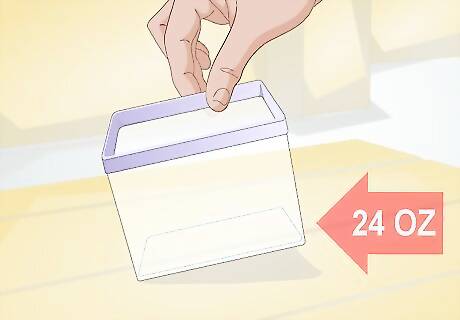
Find a container to use as an incubator. Gecko eggs need to be incubated to be healthy and safe. You will need to have an incubator ready before your gecko lays eggs so you can transfer the eggs quickly once they're laid. You can purchase an incubator at the store. This may be your easiest option as it will save you some time. However, if you're on a budget you can make an incubator. You can use a small plastic container for the incubator. You can use a deli cup or a small tupperware container. Make sure any container you use is big enough to hold at least 24 ounces.
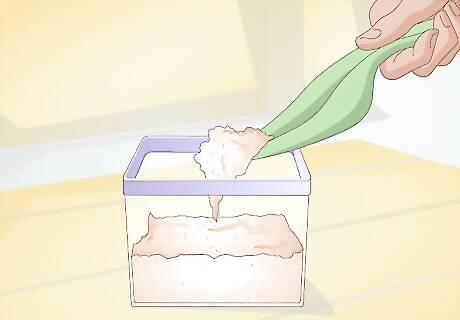
Line the bottom of your container with substrate. Substrate is the lining of the bottom of a cage. You can purchase substrate online or at a local pet store. The best materials for an incubator are the soils vermiculite or perlite. You can use one or the other, or a mixture of the two. You should put enough substrate in the container that the bottom is fully covered. There should not be any parts of the bottom of the incubator exposed. The exact amount you need will depend on the shape and size of your incubator.
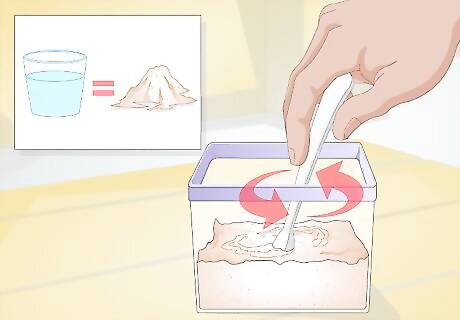
Make sure the moisture levels are correct. Gecko eggs need moisture to thrive, so you'll want to make sure the container is adequately moist. You want an equal ratio of water to the substrate, based on weight. Weigh your substrate and add an equal amount of water. For example, say your substrate is 3 ounces. You will want to match that with 3 ounces of water. You can buy a small scale at a hardware store to take measurements. Make sure the ratio is based on weight and not volume. It's very important that you keep the moisture levels appropriate as you want your geckos to be comfortable. Mix the water in with your substrate to create a moist, even mixture in the incubator. Tap water is probably safe here, but you can use filtered water or bottled water if you want to err on the side of caution.
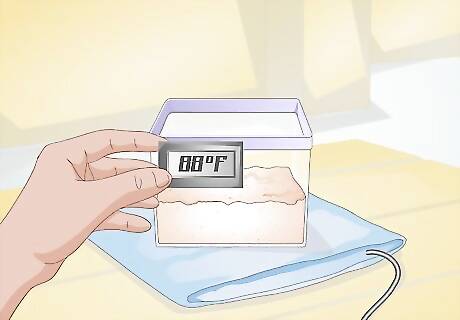
Regulate air in your incubator. Geckos need a temperature of at least 73 degrees. However, the ideal temperature is between 86 to 90 degrees Fahrenheit. You can buy a small thermometer, like an oven thermometer, to measure the temperature in your incubator. If you need your incubator to warm up slightly, you can use heat tape or an under tank heating pad. Avoid heat rocks. These could burn a gecko. Avoid air holes. You need to keep the environment for your gecko eggs warm. All you need to do is open the lid about once a week. You can let some air in, providing adequate oxygen, and check to make sure the eggs look healthy.
Handling New Eggs

Remove the eggs as soon as the female finishes laying them. Your female gecko will lay eggs somewhere in her tank, and may bury them slightly in the substrate. This will usually occur 3 to 4 weeks after mating, so be vigilant to check your female gecko around this time. She will lay eggs in batches, so not all the eggs will be laid in one sitting. Keep an eye on your gecko and notice when she is laying eggs. You will want to remove the eggs shortly after she finishes laying them. An adult gecko tank is not appropriate for eggs. Provide a moist hatching box, filled with substrate and an equal amount of water. Your gecko will naturally be drawn to a moist environment to lay her eggs. This will assure the eggs will be temporarily safe in the cage in the event your gecko lays her eggs while you're at work or school. If possible, wait until the mother has left the eggs. This way, you will not have to deal with working around the mother when you remove the eggs. Remove the eggs gently, preferably using a spoon. If you pick the eggs up with your fingers, touch them very lightly. You do not want to damage the eggs when moving them.
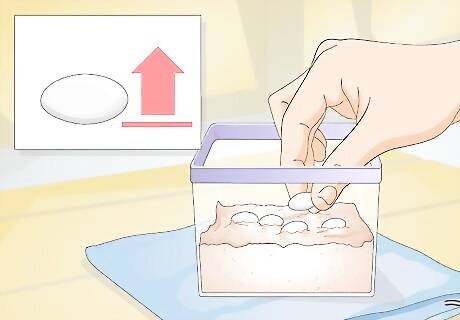
Keep the eggs in their original position. Gecko embryos attach themselves to one side of the egg shortly after birth. If you flip the eggs upside down, the embryo will die. If can help to mark the top side of the egg with a sharpie. If you choose to do so, however, mark it very lightly to avoid hurting the egg.
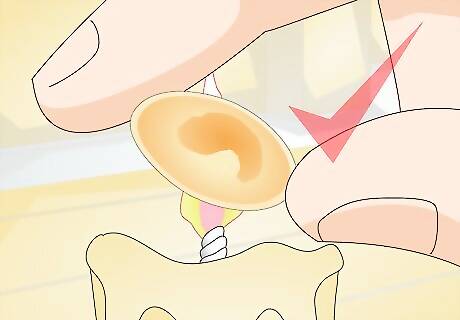
Make sure all the eggs are healthy. Not all eggs will be fertile, so check your eggs for signs of good health. It's fairly easy to tell the difference between a healthy egg and an infertile egg. A healthy gecko egg is usually hard upon hatching, and gets harder as time passes. They are oval shaped. If you hold a candle near the egg, you should be able to see the embryo inside. Infertile eggs are very soft. They have a texture similar to a water balloon. Infertile eggs may also be misshapen or shriveled in appearance. You can discard of infertile eggs if there's limited room in your incubator. However, if you have the room, it's a good idea to keep all the eggs. Sometimes, a gecko egg that initially looks unhealthy may become healthier as time passes. What appears to be infertile eggs sometimes go on to hatch.
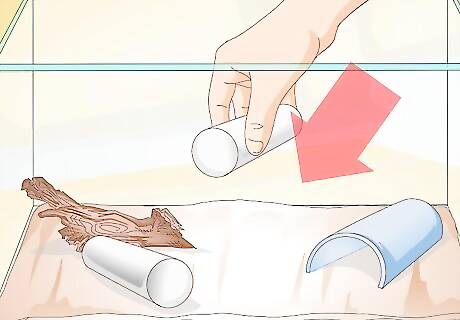
Set up a safe environment for when your eggs hatch. Geckos should be transferred to a different tank within a few hours of hatching, so have a tank for them ready to go. As you're waiting for the eggs to hatch, take steps to have a tank ready for the hatchlings. You can buy an aquarium online or at a pet store. It should be at least 10 inches long, 8 inches wide, and 6 inches high. Make sure you have a heat mat under the container to keep it warm. Use a few layers of paper towel for substrate. Also, buy small tubes and structures at a local pet store. Newborns like to have space in their cage to hide. Make sure you provide a small water bowl. You can buy a water bowl for newborns online or at a pet store. You can also use a plastic bottle cap.

Allow the eggs to hatch on their own. You do not need to intervene as the eggs start hatching. If you notice the hatching process, allow it to happen naturally. Gecko eggs do not take long to hatch, so it's possible you will check on your tank one day to find the geckos have hatched. Gecko eggs usually hatch within 35 to 89 days. Usually, you will not see the eggs hatch as it happens so quickly. You will only look in the incubator to see a gathering of gecko babies. If you see the eggs start to hatch, marked by the eggs cracking and geckos emerging, it can be fun to watch. However, you do not have to intervene.
Caring for Newborns
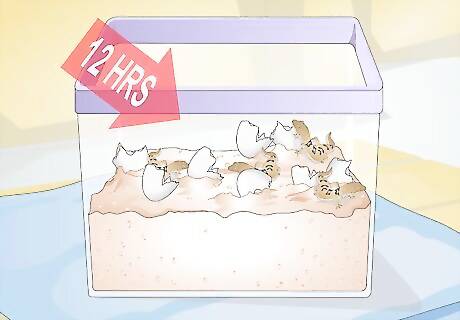
Leave newborns alone for 12 hours. Newborns will be very frightened of people after birth. Everything is new to young geckos, so leave them alone for about 12 hours. After this point, they will be used to the world and slightly more used to humans. Aim for a 12 hour range before removing the babies from the tank.
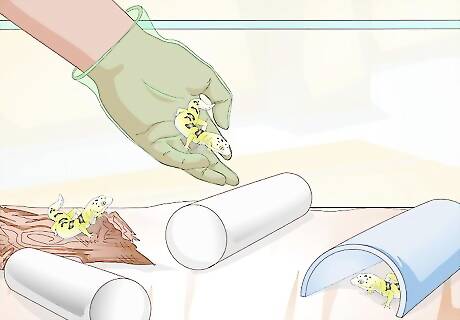
Transfer the newborns to their new environment. Carefully pick up the newborns when transferring them. You may want to wear gloves when handling newborns, as they may bite. They will be afraid of humans at first. Remain calm when transferring the geckos. They may hiss or screech as you attempt to pick them up. This sound can be startling, but reacting to it may frighten your newborns more.
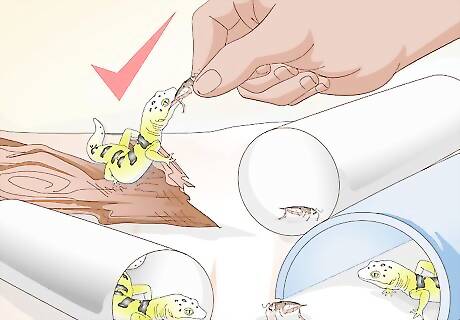
Wait a few days before feeding the newborns. Newborns absorb a lot of nutrients from the yolk of their eggs. Therefore, they will not require food until a few days after hatching. When you do feed them, make sure you provide them with appropriately sized food. Crickets are a good food for newborns, but make sure the crickets you choose are small. They should be no wider than the width of a baby's head. Do not be surprised if the geckos do not eat a lot at first. They may initially only eat one cricket per meal. Their appetite will increase as they grow.


















Comments
0 comment